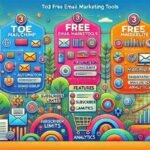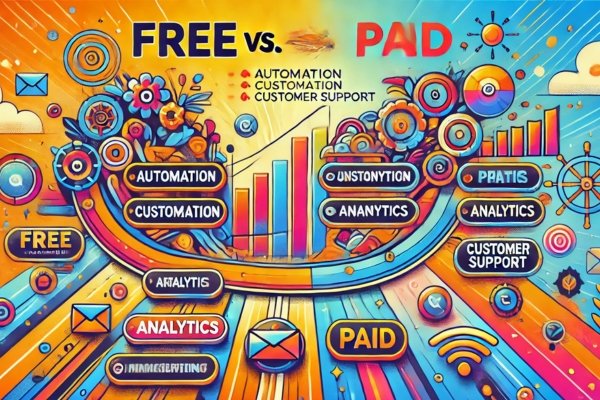
3 Best Free Email Marketing Tools in 2025 to Boost Your Campaigns
September 29, 2024
How to Integrate Email Marketing Tools with Your CRM and eCommerce Platforms
September 29, 2024In today’s digital age, email marketing remains one of the most effective ways to engage with customers, drive conversions, and build long-term relationships. As a digital marketing professional, developer, or content creator, choosing the right email marketing tool is critical. However, one pressing question often arises: should you opt for free email marketing tools or invest in paid email marketing solutions? In this article, we’ll explore the differences between free and paid email marketing platforms, helping you determine which option is truly worth your investment.
Table of Contents
1. Free Email Marketing Tools: What to Expect
Free email marketing tools are designed to provide a basic set of features that allow users to build lists, send emails, and track performance without upfront costs. For many small businesses or individuals just getting started, these tools are highly appealing. But, what can you realistically expect from them?
1.1 Limited Features and Functionality
Most free tools offer essential features such as:
- Basic email templates
- Simple automation
- List segmentation
- Basic analytics (open and click rates)
However, the more advanced features like A/B testing, dynamic content, and sophisticated automation workflows are usually reserved for paid plans. For example, Mailchimp’s free plan allows users to send up to 10,000 emails per month but lacks more complex automation options.
1.2 Restrictions on Subscriber Lists
Free plans generally impose limitations on the number of subscribers you can manage. Popular tools like MailerLite or Sendinblue allow you to send a limited number of emails per month and typically cap the size of your mailing list.
- Mailchimp free plan: 2,000 contacts
- MailerLite free plan: 1,000 subscribers
This might suffice for small businesses or startups but can become restrictive as your audience grows.
1.3 Branding and Advertisements
Free plans often display the tool’s branding at the bottom of your emails. While this may seem like a minor inconvenience, it can detract from the professionalism of your communications. For example, emails sent via Mailchimp or Benchmark free plans will have their logos and promotional messages embedded unless you upgrade.
1.4 Limited Customer Support
When using a free plan, customer support is usually limited to email or community forums. HubSpot and Sendinblue, for instance, offer premium support only to their paying customers. This lack of direct support can be a hindrance if you run into technical issues.
2. Paid Email Marketing Tools: Is It Worth the Cost?
For businesses or professionals with growing needs, paid email marketing tools open up a wide range of opportunities. They offer more advanced features, greater flexibility, and better support. Let’s explore the reasons why investing in a paid solution can pay off in the long run.
2.1 Advanced Automation and Personalization
One of the key differentiators between free and paid tools is access to advanced automation. Tools like ActiveCampaign and Klaviyo provide the ability to set up complex automation workflows that respond to specific user behaviors, such as abandoned cart emails or product recommendations.
- ActiveCampaign: Offers powerful segmentation and conditional content, enabling you to tailor emails to individual user behavior.
- Klaviyo: Provides e-commerce-focused automation and advanced personalization, making it perfect for online stores.
2.2 Unlimited Subscribers and Emails
Paid plans typically remove restrictions on the number of subscribers you can have and the number of emails you can send. For example, ConvertKit’s paid plans start with unlimited email sends, which allows you to focus on scaling your marketing efforts without worrying about caps.
2.3 Custom Branding and Design
With paid tools, you can remove third-party branding and create fully customized emails. This enhances your professionalism and branding, providing a better user experience. For instance, AWeber offers sophisticated templates and branding options to ensure your emails reflect your brand’s identity.
2.4 A/B Testing and Analytics
Paid tools often come with advanced A/B testing and detailed reporting features. You can split-test subject lines, design elements, and content to optimize your campaigns for higher conversions.
- GetResponse: Offers in-depth analytics, including detailed engagement metrics and conversion tracking.
- Campaign Monitor: Provides real-time performance tracking and robust A/B testing capabilities.
2.5 Priority Customer Support
When paying for a tool, you often receive priority support, including live chat, phone support, or even a dedicated account manager. For example, Sendinblue offers phone support to its premium customers, ensuring faster response times and more personalized assistance.
3. Cost Comparison: Free vs Paid Email Marketing Tools
It’s important to weigh the costs when comparing free and paid email marketing tools. While free tools may save you money upfront, they can cost you in terms of growth and scalability in the long run.
3.1 Free Plans: The Hidden Costs
While you don’t have to pay anything upfront for free tools, the limitations can affect your marketing success. For example, the inability to segment your audience accurately or lack of access to automation can result in missed conversion opportunities. In many cases, free plans might suffice for basic newsletters, but they fall short in sophisticated campaigns that drive revenue.
3.2 Paid Plans: The Value of Investing
Paid email marketing tools range from affordable to high-end, depending on the features you need. Here’s a rough breakdown:
- Mailchimp: Paid plans start at $10 per month, which includes advanced automation and support for larger lists.
- ActiveCampaign: Starts at $29 per month for more advanced segmentation and automation.
- ConvertKit: Starts at $29 per month, tailored specifically for creators and offering more advanced subscriber management.
While the initial investment might seem high, the advanced features of paid plans—like detailed analytics and personalized automation—often lead to better engagement and higher ROI.
4. Free vs Paid: Which One Is Right for You?
Deciding whether to use a free or paid email marketing tool largely depends on your business size, goals, and budget. Here are some factors to consider:
4.1 For Small Businesses or Beginners
If you’re just getting started or managing a small subscriber list, a free tool like Mailchimp or MailerLite might be enough to cover your needs. However, if your goal is to scale quickly or if you need advanced automation, you may soon outgrow the free plan.
4.2 For Growing Businesses or E-commerce Brands
For businesses that are scaling, investing in a paid email marketing tool can pay off in the long run. Advanced features like behavioral targeting, automation workflows, and detailed analytics can significantly improve customer engagement and boost revenue. E-commerce businesses, in particular, can benefit from tools like Klaviyo or GetResponse, which offer tailored solutions for online sales.
4.3 For Content Creators and Influencers
Content creators who want to build and monetize their audience should consider tools like ConvertKit. Its focus on simplicity combined with powerful automation makes it perfect for creators looking to grow their subscriber base and generate income through email marketing.
Comparing Free vs Paid Email Marketing Tools Comparaison
Frequently Asked Questions
What are the benefits of using paid email marketing tools?
Paid email marketing tools provide access to advanced features such as automation, detailed segmentation, A/B testing, and comprehensive analytics. These tools also offer more flexibility in terms of email design and branding, along with priority customer support.
Can I switch from a free to a paid email marketing tool later?
Yes, most email marketing platforms allow you to upgrade from a free plan to a paid plan as your needs grow. In many cases, your data (such as subscribers and emails) will transfer seamlessly to the upgraded plan.
Which email marketing tool is best for e-commerce businesses?
For e-commerce businesses, Klaviyo and ActiveCampaign are two of the best options. They offer advanced segmentation, dynamic product recommendations, and detailed automation workflows, all of which are ideal for increasing customer retention and sales.
Conclusion
When comparing free vs paid email marketing tools, the choice ultimately depends on your business goals and budget. Free tools are an excellent starting point for small businesses or individuals, but they come with limitations in features, scalability, and support. On the other hand, paid tools offer robust functionality, greater flexibility, and advanced automation, which can significantly enhance your marketing efforts and drive long-term growth.
For digital marketing professionals, developers, and content creators, the investment in a paid email marketing tool is often worth it—especially if your business is growing or you need to run sophisticated campaigns. Choose a platform that aligns with your goals, and remember, the right email marketing tool can be a game-changer for your business.








